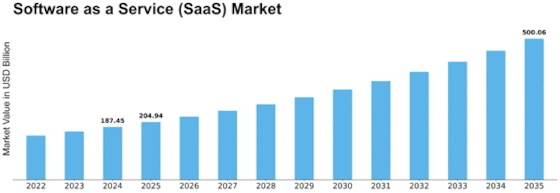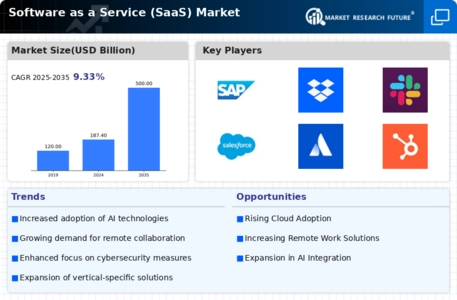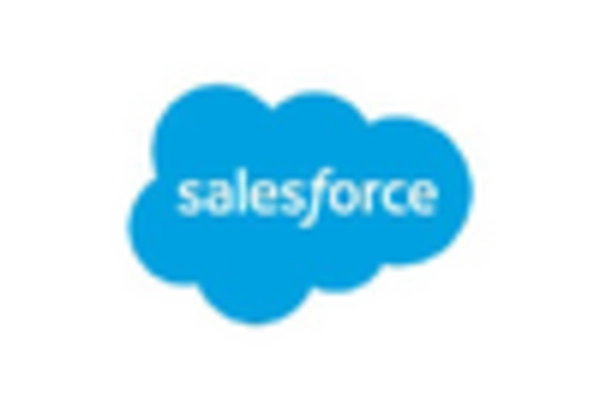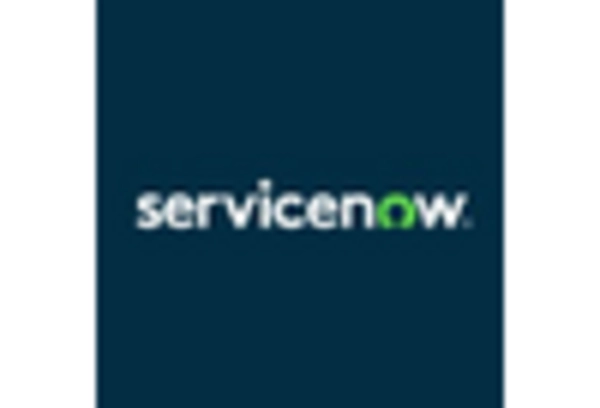Public Cloud
Private Cloud
Hybrid Cloud
Customer Relationship Management
Enterprise Resource Planning
Human Resource Management
Collaboration and Communication
Marketing Automation
Retail
Healthcare
Manufacturing
Education
Financial Services
Small Enterprises
Medium Enterprises
Large Enterprises
North America
Europe
South America
Asia Pacific
Middle East and Africa
North America Outlook (USD Billion, 2019-2035)
North America Software as a Service (SaaS) Market by Deployment Model Type
Public Cloud
Private Cloud
Hybrid Cloud
North America Software as a Service (SaaS) Market by Application Type
Customer Relationship Management
Enterprise Resource Planning
Human Resource Management
Collaboration and Communication
Marketing Automation
North America Software as a Service (SaaS) Market by Vertical Type
Retail
Healthcare
Manufacturing
Education
Financial Services
North America Software as a Service (SaaS) Market by User Type
Small Enterprises
Medium Enterprises
Large Enterprises
North America Software as a Service (SaaS) Market by Regional Type
US
Canada
US Outlook (USD Billion, 2019-2035)
US Software as a Service (SaaS) Market by Deployment Model Type
Public Cloud
Private Cloud
Hybrid Cloud
US Software as a Service (SaaS) Market by Application Type
Customer Relationship Management
Enterprise Resource Planning
Human Resource Management
Collaboration and Communication
Marketing Automation
US Software as a Service (SaaS) Market by Vertical Type
Retail
Healthcare
Manufacturing
Education
Financial Services
US Software as a Service (SaaS) Market by User Type
Small Enterprises
Medium Enterprises
Large Enterprises
CANADA Outlook (USD Billion, 2019-2035)
CANADA Software as a Service (SaaS) Market by Deployment Model Type
Public Cloud
Private Cloud
Hybrid Cloud
CANADA Software as a Service (SaaS) Market by Application Type
Customer Relationship Management
Enterprise Resource Planning
Human Resource Management
Collaboration and Communication
Marketing Automation
CANADA Software as a Service (SaaS) Market by Vertical Type
Retail
Healthcare
Manufacturing
Education
Financial Services
CANADA Software as a Service (SaaS) Market by User Type
Small Enterprises
Medium Enterprises
Large Enterprises
Europe Outlook (USD Billion, 2019-2035)
Europe Software as a Service (SaaS) Market by Deployment Model Type
Public Cloud
Private Cloud
Hybrid Cloud
Europe Software as a Service (SaaS) Market by Application Type
Customer Relationship Management
Enterprise Resource Planning
Human Resource Management
Collaboration and Communication
Marketing Automation
Europe Software as a Service (SaaS) Market by Vertical Type
Retail
Healthcare
Manufacturing
Education
Financial Services
Europe Software as a Service (SaaS) Market by User Type
Small Enterprises
Medium Enterprises
Large Enterprises
Europe Software as a Service (SaaS) Market by Regional Type
Germany
UK
France
Russia
Italy
Spain
Rest of Europe
GERMANY Outlook (USD Billion, 2019-2035)
GERMANY Software as a Service (SaaS) Market by Deployment Model Type
Public Cloud
Private Cloud
Hybrid Cloud
GERMANY Software as a Service (SaaS) Market by Application Type
Customer Relationship Management
Enterprise Resource Planning
Human Resource Management
Collaboration and Communication
Marketing Automation
GERMANY Software as a Service (SaaS) Market by Vertical Type
Retail
Healthcare
Manufacturing
Education
Financial Services
GERMANY Software as a Service (SaaS) Market by User Type
Small Enterprises
Medium Enterprises
Large Enterprises
UK Outlook (USD Billion, 2019-2035)
UK Software as a Service (SaaS) Market by Deployment Model Type
Public Cloud
Private Cloud
Hybrid Cloud
UK Software as a Service (SaaS) Market by Application Type
Customer Relationship Management
Enterprise Resource Planning
Human Resource Management
Collaboration and Communication
Marketing Automation
UK Software as a Service (SaaS) Market by Vertical Type
Retail
Healthcare
Manufacturing
Education
Financial Services
UK Software as a Service (SaaS) Market by User Type
Small Enterprises
Medium Enterprises
Large Enterprises
FRANCE Outlook (USD Billion, 2019-2035)
FRANCE Software as a Service (SaaS) Market by Deployment Model Type
Public Cloud
Private Cloud
Hybrid Cloud
FRANCE Software as a Service (SaaS) Market by Application Type
Customer Relationship Management
Enterprise Resource Planning
Human Resource Management
Collaboration and Communication
Marketing Automation
FRANCE Software as a Service (SaaS) Market by Vertical Type
Retail
Healthcare
Manufacturing
Education
Financial Services
FRANCE Software as a Service (SaaS) Market by User Type
Small Enterprises
Medium Enterprises
Large Enterprises
RUSSIA Outlook (USD Billion, 2019-2035)
RUSSIA Software as a Service (SaaS) Market by Deployment Model Type
Public Cloud
Private Cloud
Hybrid Cloud
RUSSIA Software as a Service (SaaS) Market by Application Type
Customer Relationship Management
Enterprise Resource Planning
Human Resource Management
Collaboration and Communication
Marketing Automation
RUSSIA Software as a Service (SaaS) Market by Vertical Type
Retail
Healthcare
Manufacturing
Education
Financial Services
RUSSIA Software as a Service (SaaS) Market by User Type
Small Enterprises
Medium Enterprises
Large Enterprises
ITALY Outlook (USD Billion, 2019-2035)
ITALY Software as a Service (SaaS) Market by Deployment Model Type
Public Cloud
Private Cloud
Hybrid Cloud
ITALY Software as a Service (SaaS) Market by Application Type
Customer Relationship Management
Enterprise Resource Planning
Human Resource Management
Collaboration and Communication
Marketing Automation
ITALY Software as a Service (SaaS) Market by Vertical Type
Retail
Healthcare
Manufacturing
Education
Financial Services
ITALY Software as a Service (SaaS) Market by User Type
Small Enterprises
Medium Enterprises
Large Enterprises
SPAIN Outlook (USD Billion, 2019-2035)
SPAIN Software as a Service (SaaS) Market by Deployment Model Type
Public Cloud
Private Cloud
Hybrid Cloud
SPAIN Software as a Service (SaaS) Market by Application Type
Customer Relationship Management
Enterprise Resource Planning
Human Resource Management
Collaboration and Communication
Marketing Automation
SPAIN Software as a Service (SaaS) Market by Vertical Type
Retail
Healthcare
Manufacturing
Education
Financial Services
SPAIN Software as a Service (SaaS) Market by User Type
Small Enterprises
Medium Enterprises
Large Enterprises
REST OF EUROPE Outlook (USD Billion, 2019-2035)
REST OF EUROPE Software as a Service (SaaS) Market by Deployment Model Type
Public Cloud
Private Cloud
Hybrid Cloud
REST OF EUROPE Software as a Service (SaaS) Market by Application Type
Customer Relationship Management
Enterprise Resource Planning
Human Resource Management
Collaboration and Communication
Marketing Automation
REST OF EUROPE Software as a Service (SaaS) Market by Vertical Type
Retail
Healthcare
Manufacturing
Education
Financial Services
REST OF EUROPE Software as a Service (SaaS) Market by User Type
Small Enterprises
Medium Enterprises
Large Enterprises
APAC Outlook (USD Billion, 2019-2035)
APAC Software as a Service (SaaS) Market by Deployment Model Type
Public Cloud
Private Cloud
Hybrid Cloud
APAC Software as a Service (SaaS) Market by Application Type
Customer Relationship Management
Enterprise Resource Planning
Human Resource Management
Collaboration and Communication
Marketing Automation
APAC Software as a Service (SaaS) Market by Vertical Type
Retail
Healthcare
Manufacturing
Education
Financial Services
APAC Software as a Service (SaaS) Market by User Type
Small Enterprises
Medium Enterprises
Large Enterprises
APAC Software as a Service (SaaS) Market by Regional Type
China
India
Japan
South Korea
Malaysia
Thailand
Indonesia
Rest of APAC
CHINA Outlook (USD Billion, 2019-2035)
CHINA Software as a Service (SaaS) Market by Deployment Model Type
Public Cloud
Private Cloud
Hybrid Cloud
CHINA Software as a Service (SaaS) Market by Application Type
Customer Relationship Management
Enterprise Resource Planning
Human Resource Management
Collaboration and Communication
Marketing Automation
CHINA Software as a Service (SaaS) Market by Vertical Type
Retail
Healthcare
Manufacturing
Education
Financial Services
CHINA Software as a Service (SaaS) Market by User Type
Small Enterprises
Medium Enterprises
Large Enterprises
INDIA Outlook (USD Billion, 2019-2035)
INDIA Software as a Service (SaaS) Market by Deployment Model Type
Public Cloud
Private Cloud
Hybrid Cloud
INDIA Software as a Service (SaaS) Market by Application Type
Customer Relationship Management
Enterprise Resource Planning
Human Resource Management
Collaboration and Communication
Marketing Automation
INDIA Software as a Service (SaaS) Market by Vertical Type
Retail
Healthcare
Manufacturing
Education
Financial Services
INDIA Software as a Service (SaaS) Market by User Type
Small Enterprises
Medium Enterprises
Large Enterprises
JAPAN Outlook (USD Billion, 2019-2035)
JAPAN Software as a Service (SaaS) Market by Deployment Model Type
Public Cloud
Private Cloud
Hybrid Cloud
JAPAN Software as a Service (SaaS) Market by Application Type
Customer Relationship Management
Enterprise Resource Planning
Human Resource Management
Collaboration and Communication
Marketing Automation
JAPAN Software as a Service (SaaS) Market by Vertical Type
Retail
Healthcare
Manufacturing
Education
Financial Services
JAPAN Software as a Service (SaaS) Market by User Type
Small Enterprises
Medium Enterprises
Large Enterprises
SOUTH KOREA Outlook (USD Billion, 2019-2035)
SOUTH KOREA Software as a Service (SaaS) Market by Deployment Model Type
Public Cloud
Private Cloud
Hybrid Cloud
SOUTH KOREA Software as a Service (SaaS) Market by Application Type
Customer Relationship Management
Enterprise Resource Planning
Human Resource Management
Collaboration and Communication
Marketing Automation
SOUTH KOREA Software as a Service (SaaS) Market by Vertical Type
Retail
Healthcare
Manufacturing
Education
Financial Services
SOUTH KOREA Software as a Service (SaaS) Market by User Type
Small Enterprises
Medium Enterprises
Large Enterprises
MALAYSIA Outlook (USD Billion, 2019-2035)
MALAYSIA Software as a Service (SaaS) Market by Deployment Model Type
Public Cloud
Private Cloud
Hybrid Cloud
MALAYSIA Software as a Service (SaaS) Market by Application Type
Customer Relationship Management
Enterprise Resource Planning
Human Resource Management
Collaboration and Communication
Marketing Automation
MALAYSIA Software as a Service (SaaS) Market by Vertical Type
Retail
Healthcare
Manufacturing
Education
Financial Services
MALAYSIA Software as a Service (SaaS) Market by User Type
Small Enterprises
Medium Enterprises
Large Enterprises
THAILAND Outlook (USD Billion, 2019-2035)
THAILAND Software as a Service (SaaS) Market by Deployment Model Type
Public Cloud
Private Cloud
Hybrid Cloud
THAILAND Software as a Service (SaaS) Market by Application Type
Customer Relationship Management
Enterprise Resource Planning
Human Resource Management
Collaboration and Communication
Marketing Automation
THAILAND Software as a Service (SaaS) Market by Vertical Type
Retail
Healthcare
Manufacturing
Education
Financial Services
THAILAND Software as a Service (SaaS) Market by User Type
Small Enterprises
Medium Enterprises
Large Enterprises
INDONESIA Outlook (USD Billion, 2019-2035)
INDONESIA Software as a Service (SaaS) Market by Deployment Model Type
Public Cloud
Private Cloud
Hybrid Cloud
INDONESIA Software as a Service (SaaS) Market by Application Type
Customer Relationship Management
Enterprise Resource Planning
Human Resource Management
Collaboration and Communication
Marketing Automation
INDONESIA Software as a Service (SaaS) Market by Vertical Type
Retail
Healthcare
Manufacturing
Education
Financial Services
INDONESIA Software as a Service (SaaS) Market by User Type
Small Enterprises
Medium Enterprises
Large Enterprises
REST OF APAC Outlook (USD Billion, 2019-2035)
REST OF APAC Software as a Service (SaaS) Market by Deployment Model Type
Public Cloud
Private Cloud
Hybrid Cloud
REST OF APAC Software as a Service (SaaS) Market by Application Type
Customer Relationship Management
Enterprise Resource Planning
Human Resource Management
Collaboration and Communication
Marketing Automation
REST OF APAC Software as a Service (SaaS) Market by Vertical Type
Retail
Healthcare
Manufacturing
Education
Financial Services
REST OF APAC Software as a Service (SaaS) Market by User Type
Small Enterprises
Medium Enterprises
Large Enterprises
South America Outlook (USD Billion, 2019-2035)
South America Software as a Service (SaaS) Market by Deployment Model Type
Public Cloud
Private Cloud
Hybrid Cloud
South America Software as a Service (SaaS) Market by Application Type
Customer Relationship Management
Enterprise Resource Planning
Human Resource Management
Collaboration and Communication
Marketing Automation
South America Software as a Service (SaaS) Market by Vertical Type
Retail
Healthcare
Manufacturing
Education
Financial Services
South America Software as a Service (SaaS) Market by User Type
Small Enterprises
Medium Enterprises
Large Enterprises
South America Software as a Service (SaaS) Market by Regional Type
Brazil
Mexico
Argentina
Rest of South America
BRAZIL Outlook (USD Billion, 2019-2035)
BRAZIL Software as a Service (SaaS) Market by Deployment Model Type
Public Cloud
Private Cloud
Hybrid Cloud
BRAZIL Software as a Service (SaaS) Market by Application Type
Customer Relationship Management
Enterprise Resource Planning
Human Resource Management
Collaboration and Communication
Marketing Automation
BRAZIL Software as a Service (SaaS) Market by Vertical Type
Retail
Healthcare
Manufacturing
Education
Financial Services
BRAZIL Software as a Service (SaaS) Market by User Type
Small Enterprises
Medium Enterprises
Large Enterprises
MEXICO Outlook (USD Billion, 2019-2035)
MEXICO Software as a Service (SaaS) Market by Deployment Model Type
Public Cloud
Private Cloud
Hybrid Cloud
MEXICO Software as a Service (SaaS) Market by Application Type
Customer Relationship Management
Enterprise Resource Planning
Human Resource Management
Collaboration and Communication
Marketing Automation
MEXICO Software as a Service (SaaS) Market by Vertical Type
Retail
Healthcare
Manufacturing
Education
Financial Services
MEXICO Software as a Service (SaaS) Market by User Type
Small Enterprises
Medium Enterprises
Large Enterprises
ARGENTINA Outlook (USD Billion, 2019-2035)
ARGENTINA Software as a Service (SaaS) Market by Deployment Model Type
Public Cloud
Private Cloud
Hybrid Cloud
ARGENTINA Software as a Service (SaaS) Market by Application Type
Customer Relationship Management
Enterprise Resource Planning
Human Resource Management
Collaboration and Communication
Marketing Automation
ARGENTINA Software as a Service (SaaS) Market by Vertical Type
Retail
Healthcare
Manufacturing
Education
Financial Services
ARGENTINA Software as a Service (SaaS) Market by User Type
Small Enterprises
Medium Enterprises
Large Enterprises
REST OF SOUTH AMERICA Outlook (USD Billion, 2019-2035)
REST OF SOUTH AMERICA Software as a Service (SaaS) Market by Deployment Model Type
Public Cloud
Private Cloud
Hybrid Cloud
REST OF SOUTH AMERICA Software as a Service (SaaS) Market by Application Type
Customer Relationship Management
Enterprise Resource Planning
Human Resource Management
Collaboration and Communication
Marketing Automation
REST OF SOUTH AMERICA Software as a Service (SaaS) Market by Vertical Type
Retail
Healthcare
Manufacturing
Education
Financial Services
REST OF SOUTH AMERICA Software as a Service (SaaS) Market by User Type
Small Enterprises
Medium Enterprises
Large Enterprises
MEA Outlook (USD Billion, 2019-2035)
MEA Software as a Service (SaaS) Market by Deployment Model Type
Public Cloud
Private Cloud
Hybrid Cloud
MEA Software as a Service (SaaS) Market by Application Type
Customer Relationship Management
Enterprise Resource Planning
Human Resource Management
Collaboration and Communication
Marketing Automation
MEA Software as a Service (SaaS) Market by Vertical Type
Retail
Healthcare
Manufacturing
Education
Financial Services
MEA Software as a Service (SaaS) Market by User Type
Small Enterprises
Medium Enterprises
Large Enterprises
MEA Software as a Service (SaaS) Market by Regional Type
GCC Countries
South Africa
Rest of MEA
GCC COUNTRIES Outlook (USD Billion, 2019-2035)
GCC COUNTRIES Software as a Service (SaaS) Market by Deployment Model Type
Public Cloud
Private Cloud
Hybrid Cloud
GCC COUNTRIES Software as a Service (SaaS) Market by Application Type
Customer Relationship Management
Enterprise Resource Planning
Human Resource Management
Collaboration and Communication
Marketing Automation
GCC COUNTRIES Software as a Service (SaaS) Market by Vertical Type
Retail
Healthcare
Manufacturing
Education
Financial Services
GCC COUNTRIES Software as a Service (SaaS) Market by User Type
Small Enterprises
Medium Enterprises
Large Enterprises
SOUTH AFRICA Outlook (USD Billion, 2019-2035)
SOUTH AFRICA Software as a Service (SaaS) Market by Deployment Model Type
Public Cloud
Private Cloud
Hybrid Cloud
SOUTH AFRICA Software as a Service (SaaS) Market by Application Type
Customer Relationship Management
Enterprise Resource Planning
Human Resource Management
Collaboration and Communication
Marketing Automation
SOUTH AFRICA Software as a Service (SaaS) Market by Vertical Type
Retail
Healthcare
Manufacturing
Education
Financial Services
SOUTH AFRICA Software as a Service (SaaS) Market by User Type
Small Enterprises
Medium Enterprises
Large Enterprises
REST OF MEA Outlook (USD Billion, 2019-2035)
REST OF MEA Software as a Service (SaaS) Market by Deployment Model Type
Public Cloud
Private Cloud
Hybrid Cloud
REST OF MEA Software as a Service (SaaS) Market by Application Type
Customer Relationship Management
Enterprise Resource Planning
Human Resource Management
Collaboration and Communication
Marketing Automation
REST OF MEA Software as a Service (SaaS) Market by Vertical Type
Retail
Healthcare
Manufacturing
Education
Financial Services
REST OF MEA Software as a Service (SaaS) Market by User Type
Small Enterprises
Medium Enterprises
Large Enterprises











Leave a Comment